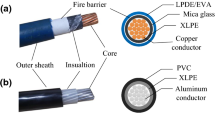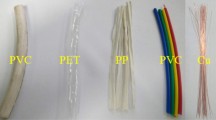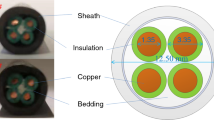Abstract
As cities grow, cables play an increasingly important role as part of the power transmission system. But as the number of cables increases, so do the safety hazards that come with them: the generation of cable arcs and even the start of fires. Cable fire blankets are necessary to protect against the initial stages of cable fires. In this paper, three different pairings are compared and analyzed by a combination of experiments and simulations. These include Kevlar-Teflon, Polyimide-Teflon, and Kevlar-Polyimide material pairings. The study illustrates the possibilities of polyimide materials for the application of cable fire blankets. The bearer of the simulation part is COMSOL software. By combining experiments and simulations with each other, the excellent fire protection properties as well as the arc resistance of polyimide are illustrated for the use of polyimide in cable protection blankets and also provide theoretical support for the application of polyimide in the field of cable protection.
Access provided by Autonomous University of Puebla. Download conference paper PDF
Similar content being viewed by others
Keywords
1 Introduction
With the development of society, electricity is more widely needed. The production development of society and people's life are inseparable from electricity. As the main bearer of the power transmission system, the cable has an irreplaceable role. With the increasing application of cables, accidents are also occurring more commonly. According to reports, cable accidents caused by fire accounted for more than 1/3 of the total incidence of fire accidents in 2020 [1, 2]. Local insulation defects in cables are often caused by prolonged overload, insulation aging, external damage, etc. Insulation breakdown occurs gradually internally when the defect occurs, but it is not easy to observe [3]. Once a complete breakdown of the cable occurs, it can cause a fire. Cable fires are rapid, accompanied by a large amount of smoke generated, while the electrical shock will pose a threat to the surrounding equipment and rescue personnel. So it is necessary to pay attention to the protection of cable fires.
Cable fire blanket as one of the means of cable fire prevention as well as initial protection, its protective effect is remarkable [4]. Currently for the main fire blanket structure analysis on the market, the main role of the Teflon material, Kevlar fabric. At the same time the current development of new polymer materials, a number of fire-retardant polymer materials appear in the field of vision, including polyimide materials, as a representative of fire-retardant materials, because of its intrinsic flame retardancy and good chemical resistance, aging resistance and other characteristics [5, 6]. Widely used in aerospace, construction and other fields [7, 8]. Meanwhile, at present, polyimide materials are also applied in electronic and electrical research, such as the research of arc-proof clothing for non-stop operation [9], but for polyimide in cable fire protection has not been studied yet. All three materials have good electrical insulation, stable chemical properties, and flame-retardant properties. This paper intends to use a combination of simulation and experiment to analyze the degree of difference between Teflon, Kevlar and flame-retardant polyimide materials for cable fire protection, to provide a theoretical basis for the subsequent breakthrough and innovation of cable protection materials, and to provide a reference for the research development in the field of electric power protection.
2 Simulation of Fabric Under the Arc
2.1 Simulation Geometry
The direct cause of cable fires is the aging of the insulation layer, resulting in discontinuous discharge of the electric arc inside the cable, which constantly continues to erode the insulation layer, and once the insulation layer is completely destroyed, the cable arc will continue to discharge, resulting in high temperatures. To address this phenomenon, this paper uses COMSOL Multiphysics finite element simulation software to construct a two-dimensional axisymmetric model containing the part of the cable that generates the arc and the part of the fabric material wrapped around the outside, as shown in Fig. 1. Using the central axis of the cable as the axis of symmetry, the section is selected for modeling, where the simulated air region is a rectangle of 50 mm in length and 40 mm in width. The single-core cable section is stripped of the outer metal shield and its outer surface layer, leaving the insulation layer. The upper end of the cable is connected to a 50 Hz high voltage power supply on the upper side and the lower end of the cable is grounded. A double layer of fabric is wrapped around the copper core of the cable. Since the polyimide fabric and the Kevlar fabric contain holes, the model in the figure shows not a continuous fabric structure. Also, since it is impossible for the fabric to fit completely on the surface of the copper core when wrapped, the simulation is represented by a 1 mm air gap. The simulation duration is 40 ms, and the initial temperature is 293.15 K.
The simulation parameters of polyimide, Kevlar and Teflon materials are shown in Table 1. According to the research, it is found that most of the commercially available cable fire blankets are made of Kevlar with Teflon, assisted by an outer layer of vitrifiable silicone rubber, and other protective effect layers. Therefore, three cases of Kevlar-Teflon, Kevlar-Polyimide and Polyimide-Teflon were selected for comparative study to analyze the thermal insulation of the three matching methods.
2.2 Analysis of Results
Set the cable load current to 250 A, and the frequency is 50 Hz. Change the different materials with the simulation analysis, and select the temperature measurement points as shown in Fig. 2. The four measurement points are (15 mm, 25 mm), (20 mm, 25 mm), (25 mm, 25 mm), (30 mm, 25 mm), respectively, to measure the temperature change of the cable arc through the fabric. The simulation time constant is 40 ms.
As shown in Fig. 3, the temperature distribution at 40 ms for three different pairing cases is shown in Fig. 3(a) for Kevlar-Teflon, Fig. 3(b) for Kevlar-Polyimide, and Fig. 3(c) for Polyimide-Teflon. The picture shows that the arc-burning phenomenon occurs in the middle of the cable at both ends, and the temperature is transferred from the three combined materials from inside to outside, and the temperature keeps spreading into the surrounding air.
As shown in Fig. 4, the temperature variation curves for three different pairing cases are plotted, Fig. 4(a) for Kevlar-Teflon, Fig. 4(b) for Kevlar-Polyimide, and Fig. 4(c) for Polyimide-Teflon. As Fig. 5 shows the comparison of the temperature profiles of the three pairings at the temperature measurement point (15 mm, 25 mm). It can be observed that the polyimide- Teflon combination has the best insulation effect and can better hinder the diffusion of high temperature gases from the cable arc. The temperature diffusion from the high temperature gas to the low temperature gas leads to a relative decrease at the near point and a gradual increase at the far point. For the Kevlar-Polyimide combination shown in the figure, it can be observed that its thermal insulation effect is poor, and the rapid penetration of the high temperature gas causes the temperature to exceed 1000 K at the beginning of 3 ms, while the commercially available Kevlar-Teflon combination shown in the figure has a slightly worse thermal insulation effect than the Polyimide-Teflon combination.
According to the related work we have done before [10, 11], it is shown that polyimide has good arc resistance, and the figure illustrates the excellent thermal insulation properties of polyimide. Therefore, for the components of cable fire blanket, it is feasible to replace Kevlar with polyimide material.
3 Material Heat Transfer Experiment
In this paper, an electric arc furnace was used as a constant radiation heat source and preheated for 20 min. The fabric materials were cut to the same size and placed at a certain distance from the heat source according to three combinations of Kevlar-Teflon, Kevlar-polyimide and polyimide-Teflon to study the heat insulation effect of different combinations. Windproof panels were erected around the experimental equipment to prevent the influence of outside air flow on the experimental results. Each group of paired experiments lasted for 36 s, and the temperature of the back side of the fabric was measured using a temperature sensor to obtain the temperature distribution images shown in Fig. 6.
As shown in the figure, it can be found that the heat transfer change curve of polyimide-Teflon is basically the same as that of Kevlar-Teflon, which finally stays at about 480 K, while the heat transfer change curve of Kevlar-polyimide shows that its temperature changes faster and rises more rapidly, while the final temperature stays above 500 K, indicating that its heat insulation effect is worse than that of the other two groups. This can show that the heat insulation effect of polyimide-Teflon and Kevlar-Teflon is similar, which is the same as the conclusion of the experiment, and can show that the polyimide material can replace the Kevlar material in the application of cable fire blanket.
4 Conclusions
This paper simulates and compares and analyzes the heat insulation effect of three different material combinations on cable arc, the combination of polyimide material and Teflon material has the best heat insulation effect, followed by the combination of Kevlar material and Teflon material, the worst heat insulation performance is the combination of Kevlar material and polyimide material, which makes the external temperature after placing more than 30% higher than the other components, while the difference between the other two groups is less than 10%. The simulation analysis shows that the polyimide material can replace the Kevlar fiber as a component of the cable fire blanket from the heat insulation point of view. The correctness of the simulation is also confirmed by experimental means. it is shown through experiments that the breakdown resistance characteristics of the combination of polyimide material and Teflon are similar to those of the combination of Kevlar material and Teflon material, and it is shown from the perspective of arc breakdown resistance characteristics that polyimide material can replace Kevlar fiber as a component of cable fire blanket.
References
Ge, F., Qiu, T., Zhang, M., et al.: Experimental research on the thermal characteristic of low-voltage alternating current (AC) arc faults. Fire Saf. J.Saf. J. 136, 103732–103739 (2023)
Li, C., Chen, J., Zhang, W., et al.: Influence of arc size on the ignition and flame propagation of cable fire. Energies 14(18), 5675–5687 (2021)
Li, L., Li, Y., Zhou, X., et al.: Modeling of internal multiform intermittent arc fault for 10kV XLPE Cable. Trans. China Electrotech. Soc. 37(23), 6104–6115 (2022). (in Chinese)
Huang, H., Wu, Z., He, W., et al.: Research on segmental barrier technology of non-flame-retardant cables based on fire blanket. Electr. Eng.. Eng. 24, 155–158 (2021). (in Chinese)
Zhang, M., Niu, H., Wu, D.: Polyimide fibers with high strength and high modulus: preparation, structures, properties, and applications. Macromol. Rapid Commun.. Rapid Commun. 39(20), 1800141–1800154 (2018)
Zhang, Q.H., Dong, J., Wu, D.Z.: Advanced polyimide fibers. Advanced Polyimide Materials, pp. 67–92. Elsevier (2018)
Morgan, A.B., Putthanarat, S.: Use of inorganic materials to enhance thermal stability and flammability behavior of a polyimide. Polym. Degrad. Stab.. Degrad. Stab. 96(1), 23–32 (2011)
Cai, G., Xu, Z., Li, W., et al.: Experimental investigation on the thermal protective performance of nonwoven fabrics made of high-performance fibers. J. Therm. Anal. Calorim.Calorim. 121, 627–632 (2015)
Hou, Z., Ma, C., Ju, Z., et al.: Analysis of arc-proof performance of polyimide fabrics. Cotton Textile Technol. 50(03), 44–47 (2022). (in Chinese)
Ma, C., Duan, X., Yue, P., et al.: Comparative analysis of polyimide and aramid fabrics as arc protective materials. Textile Res. J. (to be published). https://doi.org/10.1177/00405175231158819
Tang, M., Yue, P., Duan, X., et al.: Research on the influence of fault Arc on polyimide insulation materials. J. Phys. Conf. Ser. 2419(1), 012081–012087 (2023)
Acknowledgments
This work was supported by the State Grid Shaanxi Electric Power Company Limited and the State Grid Shaanxi Electric Power Research Institute (Project No. 5226KY230010).
Author information
Authors and Affiliations
Corresponding author
Editor information
Editors and Affiliations
Rights and permissions
Copyright information
© 2024 Beijing Paike Culture Commu. Co., Ltd.
About this paper
Cite this paper
Yun, X., Ju, Z., Zhang, Y., Kong, F., Ma, C., Duan, X. (2024). Insulation Performance of Polyimide Materials Under Cable Arc. In: Yang, Q., Li, Z., Luo, A. (eds) The Proceedings of the 18th Annual Conference of China Electrotechnical Society. ACCES 2023. Lecture Notes in Electrical Engineering, vol 1167. Springer, Singapore. https://doi.org/10.1007/978-981-97-1064-5_5
Download citation
DOI: https://doi.org/10.1007/978-981-97-1064-5_5
Published:
Publisher Name: Springer, Singapore
Print ISBN: 978-981-97-1063-8
Online ISBN: 978-981-97-1064-5
eBook Packages: EngineeringEngineering (R0)










